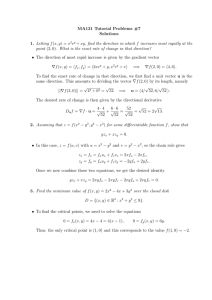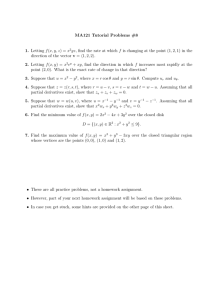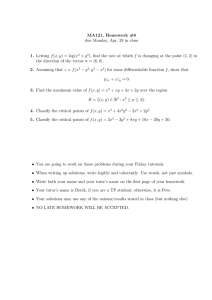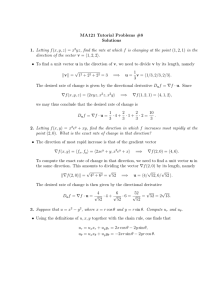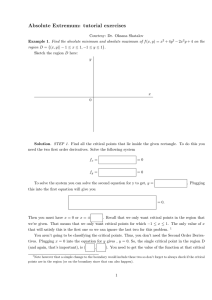MA121 Tutorial Problems #7 f xy ,
advertisement
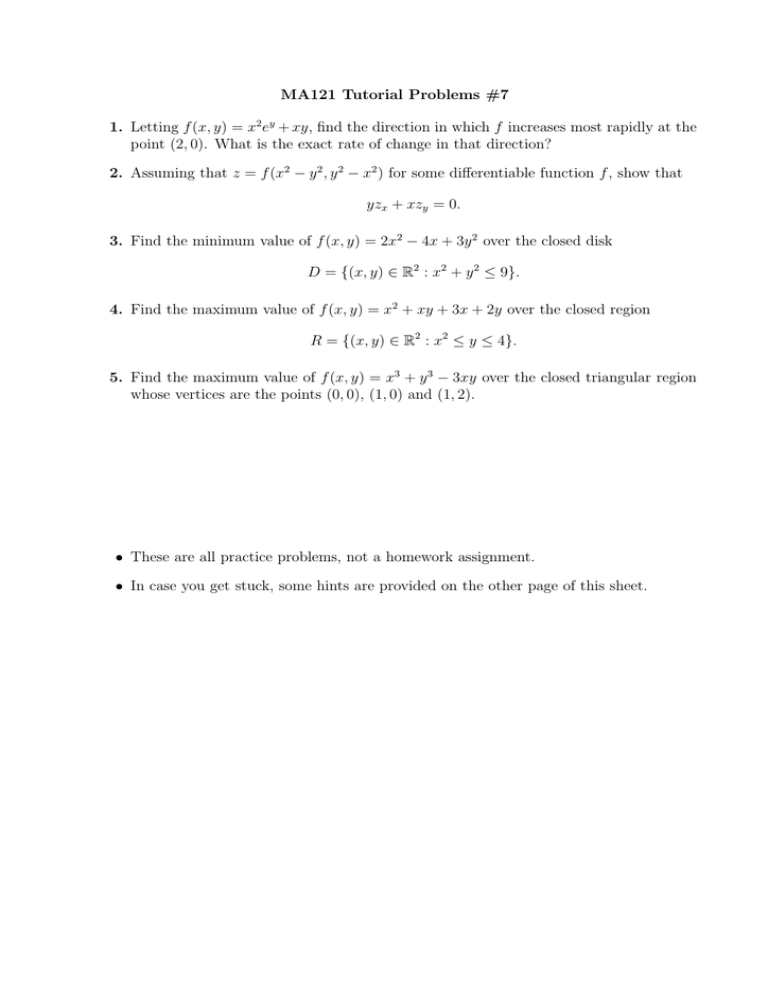
MA121 Tutorial Problems #7
1. Letting f (x, y) = x2 ey + xy, find the direction in which f increases most rapidly at the
point (2, 0). What is the exact rate of change in that direction?
2. Assuming that z = f (x2 − y 2 , y 2 − x2 ) for some differentiable function f , show that
yzx + xzy = 0.
3. Find the minimum value of f (x, y) = 2x2 − 4x + 3y 2 over the closed disk
D = {(x, y) ∈ R2 : x2 + y 2 ≤ 9}.
4. Find the maximum value of f (x, y) = x2 + xy + 3x + 2y over the closed region
R = {(x, y) ∈ R2 : x2 ≤ y ≤ 4}.
5. Find the maximum value of f (x, y) = x3 + y 3 − 3xy over the closed triangular region
whose vertices are the points (0, 0), (1, 0) and (1, 2).
• These are all practice problems, not a homework assignment.
• In case you get stuck, some hints are provided on the other page of this sheet.
Hints and comments
1. The direction of most rapid increase is that of the gradient vector
∇f (x, y) = hfx , fy i = h2xey + y, x2 ey + xi
=⇒
∇f (2, 0) = h4, 6i.
√
Find a unit vector u in the same direction and compute Du f = ∇f · u = 2 13.
2. In this case, z = f (u, v) with u = x2 − y 2 and v = y 2 − x2 , so the chain rule gives
zx = fx = fu ux + fv vx = 2xfu − 2xfv ,
zy = fy = fu uy + fv vy = −2yfu + 2yfv .
3. Since fx (x, y) = 4x − 4 and fy (x, y) = 6y, the only critical point is (1, 0), while
y 2 = 9 − x2
f (x, y) = 2x2 − 4x + 3(9 − x2 ) = −x2 − 4x + 27
=⇒
on the boundary. You need to find the minimum value of this function on [−3, 3].
4. There is only one critical point, but it fails to lie in the region, so you may ignore it.
The boundary consists of two parts to be treated separately. For the part that lies
along the parabola y = x2 , you need to find the maximum value of
g(x) = f (x, x2 ) = x3 + 3x2 + 3x
over the closed interval [−2, 2]. For the remaining part of the boundary, we have
y=4
f (x, y) = f (x, 4) = x2 + 7x + 8
=⇒
and you need the maximum value of this function over the closed interval [−2, 2].
5. There are two critical points, namely (0, 0) and (1, 1). To check the boundary points,
consider the three sides of the triangle separately. On the horizontal side,
y=0
=⇒
f (x, y) = x3
and we have 0 ≤ x ≤ 1, so the maximum value is f (1, 0) = 1. On the vertical side,
x=1
=⇒
f (x, y) = y 3 − 3y + 1
so you need the maximum value of this function when 0 ≤ y ≤ 2. On the hypotenuse,
y = 2x
=⇒
f (x, y) = x3 + (2x)3 − 3x(2x) = 9x3 − 6x2
so you need the maximum value of this function when 0 ≤ x ≤ 1.
